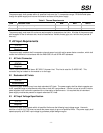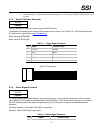
SSI
ERP2U Power Supply Design Guide, V2.31
- 12 -
Table 3: AC Input Rating
PARAMETER MIN RATED MAX
Voltage (110) 90 V
rms
100-127 V
rms
140 V
rms
Voltage (220) 180 V
rms
200-240 V
rms
264 V
rms
Frequency 47 Hz 63 Hz
5.4 Input Under Voltage
STATUS
Required
The power supply shall contain protection circuitry such that application of an input voltage below the minimum
specified in section
5.3 shall not cause damage to the power supply.
5.5 Efficiency
STATUS
Recommended/Required
The following table provides recommended and required minimum efficiency levels. These are provided at three
different load levels; 100%, 50% and 20%. The “required” minimum efficiency levels are for the purpose of proper
power supply cooling when installed in the system. The “recommended” minimum efficiency levels are for the
purpose of reducing the system’s AC power consumption. The efficiency is specified at 50% and 20% loading
conditions to help reduce system power consumption at typical system loading conditions.
Efficiency shall be tested at AC input voltages of 115VAC and 230VAC. Refer to
www.efficientpowersupplies.org
for details on proper efficiency testing methods.
Table 4: Efficiency
Loading 100% of maximum 50% of maximum 20% of maximum
Required minimum 70% 72% 65%
Recommended minimum 80% 83% 78%
5.6 AC Line Dropout
STATUS
Required
An AC line dropout is defined to be when the AC input drops to 0 VAC at any phase of the AC line for any length
of time. During an AC dropout of one cycle or less the power supply must meet dynamic voltage regulation
requirements up to 75% of the rated output load. An AC line dropout of one cycle or less shall not cause any
tripping of control signals or protection circuits. If the AC dropout lasts longer than one cycle or the load is greater
than 75%, the power supply should recover and meet all turn on requirements. The power supply must meet the
AC dropout requirement over rated AC voltages, frequencies, and output loading conditions. Any dropout of the


















